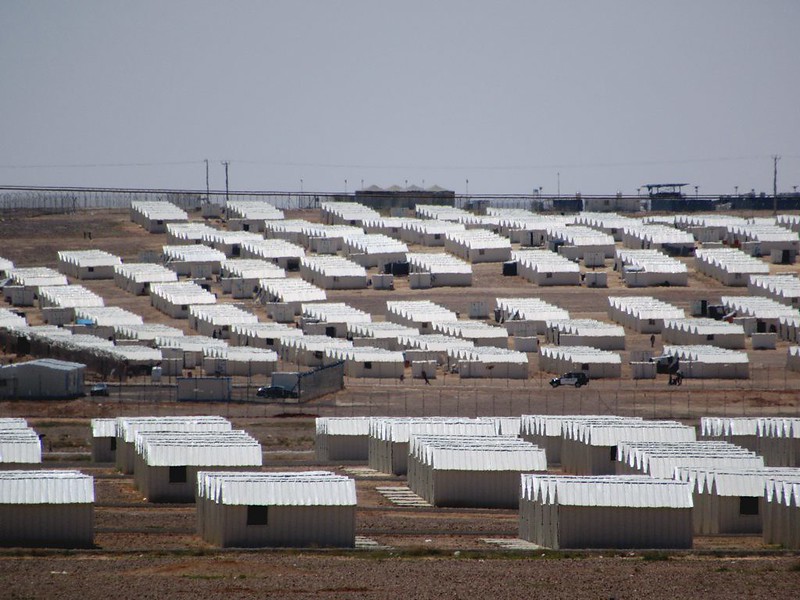Idlib's Internally Displaced Persons Crisis
A government offensive in Syria's last rebel area has triggered the largest displacement of the nine-year civil war. The catastrophe in Idlib demonstrates the need for a new policy to protect the internally displaced.

Published by The Lawfare Institute
in Cooperation With

The largest displacement of the nine-year Syrian civil war is currently unfolding in the northwestern part of the country. As the Syrian government bombards the city of Idlib—Syria’s last rebel-held area—nearly 1 million have fled toward Turkey since December 2019 in hopes of safety. Yet, Turkey has not let them in; it has kept its border effectively closed to asylum seekers since 2015. Turkey already hosts 3.6 million Syrians and has argued that it cannot bear the weight of additional refugees. As a result, Syrians at the border are trapped. Though Russia and Turkey have agreed on a tentative cease-fire, the failure of previous cease-fires does not bode well for Syrians’ safe return.
This humanitarian crisis is the latest failure of the international legal regime to protect individuals displaced by conflict. Though the 1951 Refugee Convention outlines obligations for states’ treatment of refugees and asylum seekers, there is no such legal instrument for internally displaced persons (IDPs). As opposed to refugees and asylum seekers, who are displaced across state borders, IDPs are forced to migrate within their country of residence. The disparate protections afforded to refugees compared to IDPs have enabled the international community to deny responsibility by simply keeping their doors shut—both to IDPs fleeing new violence and to refugees trapped in unsafe countries of first displacement. This trend will only worsen if developed states further undermine the global refugee regime by decreasing refugee resettlement and freezing asylum. The current situation in Syria underscores the need to recognize that international obligations to displaced persons do not stop at borders. If the international community cannot protect Syrians from being displaced, it must at a minimum ensure their ability to flee.
The Legal Status of IDPs
In October 2019, the U.N. secretary-general established the High-Level Panel on Internal Displacement, with the first meeting convening Feb. 25-27 of this year. This meeting could not have come at a more critical time. Approximately 41.3 million individuals are internally displaced globally, exceeding the 25.9 million people who are refugees outside of their home countries. In Syria, 6.2 million people are IDPs, in addition to the 6.7 million Syrian refugees around the globe. While many IDPs reside in Syria’s cities or rural areas, about 870,000 were living in camps or informal settlements as of the end of 2018. That number is likely to have increased dramatically with the latest onslaught.
In 1998, the U.N. Commission on Human Rights adopted a resolution noting the Guiding Principles on Internal Displacement. The principles combine existing international human rights and humanitarian law in the specific context of IDPs. The prohibition of deliberate forcible displacement, the right to a basic standard of living and the right of safe return are all included in the principles. These draw on both universally binding international treaties such as the Geneva Conventions as well as international human rights and humanitarian norms. While the principles themselves constitute what scholars have termed “soft law”—as opposed to the Refugee Convention, which is legally binding for signatories—the extensive legally binding protections afforded to civilians during conflict should also extend to IDPs.
The Erosion of International Law
Yet the Syrian government has demonstrated a blatant disregard for international law. Since the early years of the war, the government has targeted civilians with impunity. The regime has not spared IDPs, with government bombings killing at least 22 civilians in an IDP camp in November 2019. The government has justified its attacks on civilians by asserting that any people living within opposition-held areas are terrorists. While international law prohibits deliberate forcible displacement, both the government and some rebel groups have employed the tactic as a tool of war.
Unable to ensure the protection of civilians within Syria, the international community has also failed to support Syrians’ access to refuge in neighboring countries. Lebanon, Jordan and Iraq are not signatories to the Refugee Convention, and Turkey has limited its definition of refugees to those originating in Europe. However, all countries are bound under customary international law not to return refugees to danger under the principle of non-refoulement. Due to a variety of reasons—fears over terrorism, other domestic concerns and developed countries’ unwillingness to take refugees themselves—neighboring countries have all partially or fully closed their borders to Syrian refugees since 2015. Since they are prevented from crossing the border, Syrian IDPs seeking safety have remained at the mercy of the Syrian government, which is responsible for guaranteeing the rights of Syrian IDPs under international humanitarian law.
The erosion of refugee protection has contributed directly to the current situation for IDPs in Syria, with disastrous consequences. In 2018, for example, the Jordanian government refused to admit asylum seekers fleeing the Syrian government’s retaking of southern Syria. While most IDPs eventually returned or left for Idlib or other parts of Syria following a deal brokered between rebels and the government, the situation is far from stable. Assassinations of those suspected of association with the rebels or with the government have been commonplace. Thousands remain in a desolate camp on the Syria-Jordan border, with aid often taking months to reach them.
The future of IDPs in northwestern Syria is even more grim. The Turkish government has ramped up efforts to defend the area, unwilling to cede strategic ground in Syria or to allow additional refugees to enter Turkey. Meanwhile, children are dying of exposure as a result of the bitter cold, and aid organizations are struggling to meet the level of need of those displaced at the border. With Idlib the place of “last refuge” for many Syrians from other formerly rebel-held areas within Syria, the prospect of a government takeover is a death sentence for many. Imprisonment and execution of political prisoners has been a common government strategy throughout the war. Because northwestern Syria is controlled in large part by Hayat Tahrir al-Sham, a jihadist group previously associated with al-Qaeda, the government may use this as a justification to continue indiscriminate targeting of both armed rebels and civilians in the future.
A Way Forward?
Policymakers have both short-term and long-term options to address the status of IDPs in Syria and globally. These solutions will have implications not just for Syria but also for future conflicts.
In the short term, international leaders must ensure that Russia and the Syrian government stop indiscriminate attacks against civilians at the Turkish border. Ensuring that Turkey retains leverage to maintain the agreed-upon cease-fire is necessary to prevent further catastrophic loss of life and displacement. While Turkish President Recep Tayyip Erdogan has requested U.S. support in Idlib, the U.S. government’s willingness to engage has been limited throughout the conflict. Renewed U.S. pressure on Russia would be a crucial step in addressing the situation. European diplomatic and humanitarian efforts are even more important in the face of U.S. disengagement. Significantly increasing both resettlement to third countries and economic and humanitarian assistance for Turkey from Western and Gulf countries may help to incentivize Turkey to allow in particularly vulnerable asylum seekers. However, an approach that merely ensures IDP safety at the border and not within Syria more broadly would condemn Syrians who have fled to indefinite displacement in dire conditions.
With more than 50 percent of Syria’s prewar population displaced, it will take long-term political and legal frameworks to establish safe conditions for both those who choose to return and those who remain displaced abroad. Experts have advocated for more substantive talks between the regime and rebel groups to achieve a political solution, including groups that both the Syrian government and Turkey deem terrorists. Yet IDPs and refugees cannot and should not return home without strong signals that their rights will be protected—signals that so far have been entirely absent.
Regional legal instruments offer one potential way to protect IDPs and refugees. The African Union has adopted an approach that actors in the Middle East should look to emulate. In 2009, the African Union adopted the Kampala Convention to address displacement. While there are significant implementation issues and displacement remains high, the convention represented an important step forward for protecting IDPs while they are displaced inside their countries and for facilitating their safe and voluntary return. Casting displacement as a regional issue rather than singling out one country was a key strategic move to addressing both internal and cross-border displacement. The regional nature of the deal also enabled member countries to address challenges specific to the African context.
A similar convention for the Middle East could be crucial given the approximately 11 million IDPs in the region. One challenge: How to get Syria on board? Countries could try to incentivize Syrian membership using economic and political means—a carrot-and-stick approach utilizing sanctions, access to reconstruction assistance or renewed membership in the Arab League. The likelihood is faint that such an approach would ultimately garner a credible guarantee of safe and voluntary return—the regime remains intransigent on reform, and ongoing sanctions have failed to prevent mass violence against civilians. A commitment without extensive buy-in from the displaced themselves also only raises the threat of refusing asylum under pretense of safety, as has occurred in southern Syria. Enacting incentives and ensuring enforcement would require substantial effort from the U.S. and Europe that has been scarce thus far. Yet without an enforceable commitment, the Middle East’s displacement crisis is impossible to resolve. In its absence, the only way forward is for neighboring countries to allow IDPs to resume seeking asylum as refugees.
In the face of humanitarian disaster, international leaders have an opportunity to recommit to the rights of displaced persons through increasing resettlement and supporting the development of additional protections for IDPs. The violence facing IDPs is a product of the crumbling global refugee regime set up in the wake of World War II. The latest scenes from the EU border with Turkey, where refugees and migrants are being teargassed, shot at and detained, is only the culmination of a breakdown of the right to asylum. As developed states shutter their borders, they cannot expect that developing countries will not do the same. Without an escape route, IDPs are subject to the mercy of the very parties responsible for their displacement. In the absence of protecting civilians, failing to even ensure safe refuge sets a dire precedent.





